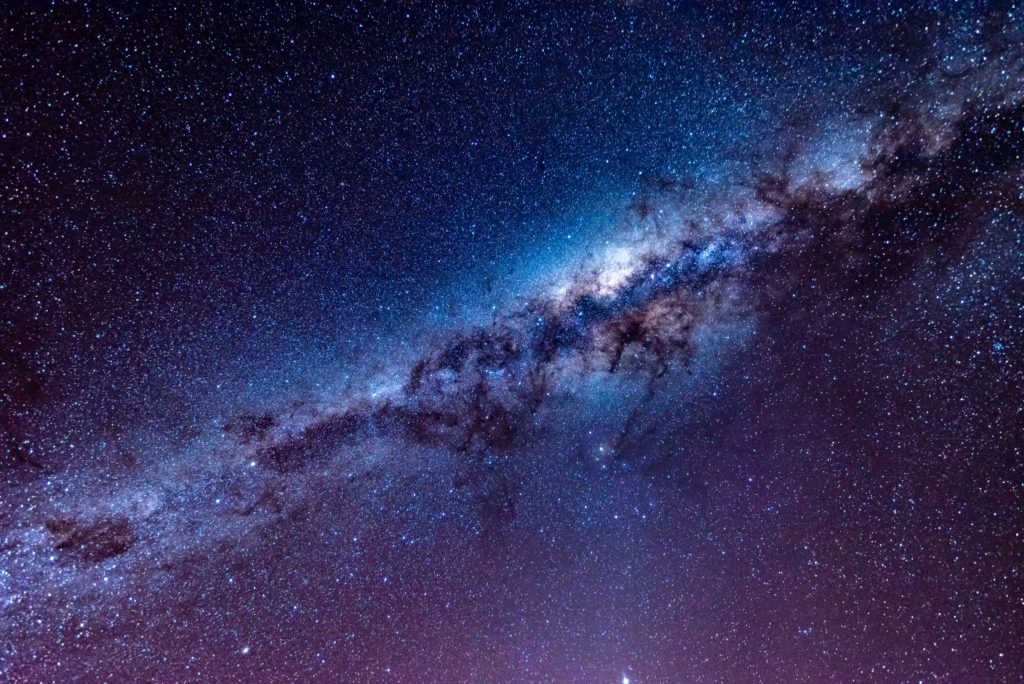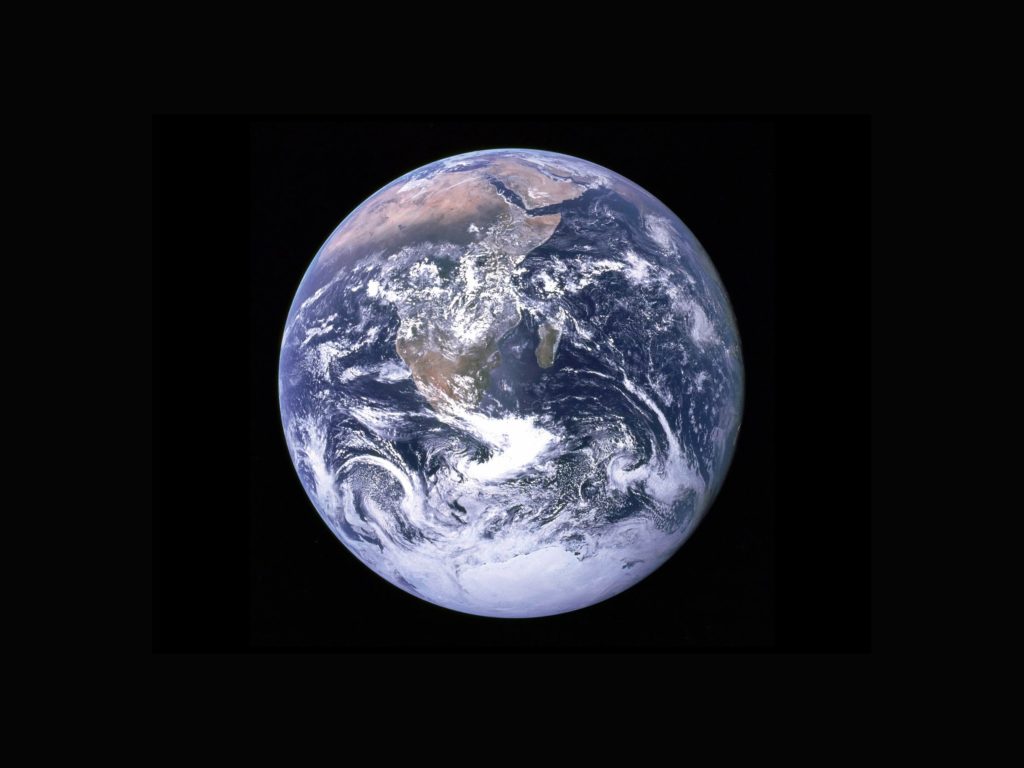“Far out in the uncharted backwaters of the unfashionable end of the Western Spiral arm of the Galaxy lies a small unregarded yellow sun. Orbiting this at a distance of roughly ninety eight million miles is an utterly insignificant little blue-green planet” .
Douglas Adams, The Hitchhiker’s Guide to the Galaxy
Lone observers of our Universe?
As an astronomer, I study how galaxies like our own Milky Way form and change over time. Why do some galaxies get really, really big, hosting billions of stars, while others stay tiny, with less than a million stars? Why are some galaxies spiral in shape and blue in colour, while others are red and rugby ball shaped? Why do some contain lots of gas and dust, while others do not? But this blog post is not about galaxies, it is about the ethics of studying galaxies in the face of the climate crisis.

The science of astronomy is about understanding our place in the Universe. It has allowed us to understand that our “unregarded yellow sun” is a very ordinary star that lies about 150,000,000,000,000,000 miles from the centre of our Galaxy, the Milky Way, and hurtles around the centre of the Milky Way at 490,000 miles per hour. We are kept from flying off into space by the pull of the mass of billions of other stars, a large amount of (predominantly hydrogen) gas and a smattering of something else (so-called dark matter). Over the last 100 years since galaxies other than our own were identified, we have learnt that the Milky Way is just one of 100 billion galaxies in the observable Universe, each with its own millions to billions of stars. Given that the vast majority of those stars, in every one of those galaxies, is capable of hosting its own habitable planet(s), it seems implausible that other intelligent life isn’t out there. Light (and therefore information) takes about 100,000 years to travel across the diameter of the Milky Way, and humans were still living in caves 100,000 years ago, so perhaps the fact that extra-terrestrial intelligent life hasn’t been discovered is just a matter of time.
Yet, given the lack of any evidence to the contrary, let’s consider for a moment that we might just be the sole beings capable of observing the Universe, of measuring those distances, those timescales, and speeds. We will likely never know for sure what our true role is in the Universe. Perhaps we are the vast planet-like computer, designed to answer the meaning of life, as imagined by Douglas Adams in the Hitchhiker’s Guide.
In the Hitchhiker’s Guide, planet Earth was destroyed five minutes prior to completion of the computer program. We were vaporised, apparently to make way for an intergalactic highway. Unlike the recent film “Don’t look up”, Hitchhiker’s Guide was not written as an allegory for the climate crisis. However, from our vantage point of 2022, it looks like we will destroy our own planet long before the intergalactic highway builders get to us. Whatever way humankind ends their days, it is possible that we take with us the only life form in the entire Universe capable of understanding our place within it. Astronomers are uniquely placed to understand this point, and to argue for the increased care of our little blue-green planet in the face of the climate crisis. Sadly, this is not what we have been doing.
An Astronomer’s Dilemma
Astronomers collect light from objects that are so distant no humans can lay claim to them, and we analyse and interpret the data in a way that causes no direct harm to any living creature. Because of this, ethical concerns arise far less often than in other subject areas. The ethical concerns of building telescopes on sacred land, and naming telescopes after personalities who stood for values which no longer have a place in our community, have been covered by other authors [1,2], and are not the topic of this post. But what are the ethical implications of astronomy in the context of climate change? I have always been acutely aware of the cost of our enterprise. As an example, the James Webb Space Telescope, launched on Christmas Day 2021, will provide unprecedented new information on how early galaxies turn their gas into stars, with a staggering price tag of $10 billion. That single telescope alone is costing about a fifth of the annual US foreign aid budget, or 7% of the annual NHS England budget. Given the many millions of people living in abject poverty and the millions awaiting lifesaving medicines or operations, the cost of modern astronomy has always made me squirm a little. On the other hand, not doing astronomy seems akin to not doing art, music or everything else that makes humans human. “Mostly harmless” is the entry into the Hitchhiker’s Guide for planet Earth. Despite its price tag, “mostly harmless” is how I have viewed the field of astronomy until recently.
But now there’s an added twist… that same James Webb Space Telescope with a price tag of $10 billion will result in something like 300,000 tonnes of CO2e emitted into our atmosphere. For several years prior to the pandemic many professional astronomers had started trying to reduce the number of plane journeys we took by reducing the number of conferences we attended, opting for remote operation of telescopes and working remotely with collaborators. Some had pondered the impact of our supercomputers [3,4], making computer codes more efficient, or simply running them in countries with cleaner energy grids. But few of us had considered the impact of the infrastructure – the telescopes, research labs, technology development and rocket launches. A recent analysis has shown that the infrastructure used by astronomers to study our Universe is responsible for the carbon equivalent emissions of a small country like Bulgaria or Croatia [5]. That’s in the order of 36 tonnes of CO2e per astronomer per year, before even accounting for flights and supercomputers which add up to another 20 or so tonnes[1] making my attempts at an increasingly carbon neutral lifestyle look like a drop in the ocean compared to my professional carbon footprint.
While some astronomical organisations are trying to create a sustainable future for the field [see e.g. 6] many others have not caught on. The European Astronomy Society is not allowing remote participation at their annual conference this year, even though we know that the carbon footprint of virtual conferences is less than a single delegate attending in-person [7], and virtual conferences are better for inclusivity too [8]. The Atacama Large Millimetre Array which started operations only a decade ago has the largest operational carbon footprint of all instruments. It is powered by 9MW diesel and gas turbines [9], despite being in a desert at an altitude of 5km where there is abundant solar and wind energy available.
There’s no Planet B

Astronomers are arguably the best qualified to explain that there really is no Planet B. Our scientific training means we are more than capable of understanding the science of the Earth’s climate. Our data analysis and modelling methods are similar to climate science, and we can hear and process what the climate scientists have been saying for decades. Our own science is driven forward by abundant creativity and imagination, complex and “out of this world” ideas are the bread and butter of our trade, and up and coming technology drives us forward. Astronomers have all the skills necessary to be leaders in decarbonising our science. Our persistence in returning to the pre-pandemic old-normal way of doing science is inexcusable, and a canary in a coal mine for where planet Earth is heading.
So where now? We need the imagination to see a different way of doing things and the bravery to act. Some steps are easy, and already being taken in places, such as to decarbonise the energy sources used to power both the construction and running of observatories. Moving forward, funding agencies who have been so keen to jump on the “impact” bandwagon, could assess the negative impacts (and mitigation plans) for grant proposals. The universally ignored “ethics” box could become a mandatory component of funding applications. Large bodies such as the International Astronomy Union and Royal Astronomical Society, alongside encouraging remote participation at international conferences, could gather and store data on relevant carbon footprints, to guide those concerned astronomers into making lower carbon choices. New infrastructure being built or at advanced stages of planning, such as the Square Kilometre Array, Vera Rubin telescope, and the ESOs Extremely Large Telescope, could factor sustainability into determining where components are built, not simply politics and money. And finally, given the climate emergency is here and now, we need to seriously consider redefining “progressive” science. We could learn to value deeper and more comprehensive exploration of our extensive data archives, rather than building the next great facility to capture ever more objects, observe them at yet another wavelength, or with greater angular resolution or depth, at least until global emissions are under control. There are undeniably those who will disagree, including powerful astronomers in powerful organisations [10], so we need an organised networking framework through which we can build consensus to fight against the deniers. One example is the grass-roots Astronomers 4 Planet Earth group movement of astronomy students, educators, amateurs and scientists with the aim of sharing knowledge and tools with both astronomers and the public to address the climate crisis [11].
As an astronomer, I hope that the knowledge I gain, and pass on to future generations, will contribute in some small way to humankind’s pursuit of the “meaning of life”. I hope that the skills I pass onto my students will allow them to continue this pursuit of knowledge for knowledge’s sake. Or, even better, perhaps they’ll go out into the big wide world and help solve global challenges. While climate ethics is not something astronomers have routinely considered up till now, there is no escaping the fact that humans’ endeavour to understand our Universe is certainly not “mostly harmless”. The cover of the Hitchhiker’s guide to the Galaxy says (in large, friendly letters) “Don’t Panic”, a motto I try to live my life by. However, the potential to wipe out the only beings in the Universe capable of measuring and understanding it seems a worthwhile thing to panic about.
References
[1] Fox and Prescod-Weinstein, The Nation, July 2019 https://www.thenation.com/article/archive/mauna-kea-tmt-colonial-science/ [2] Prescod-Weinstein et al., Scientific American, March 2021 https://www.scientificamerican.com/article/nasa-needs-to-rename-the-james-webb-space-telescope/ [3] Stevens et al. 2020, Nature Astronomy, https://www.nature.com/articles/s41550-020-1169-1 [4] Jahnke et al. 2020, Nature Astronomy, https://www.nature.com/articles/s41550-020-1202-4 [5] Knödlsader et al. 2022, Nature Astronomy, https://www.nature.com/articles/s41550-022-01612-3 [6] Pultarova 2022 https://www.space.com/reducing-carbon-footprint-of-astronomy [7] Burtscher et al. 2020, Nature Astronomy, https://www.nature.com/articles/s41550-020-1207-z [8] Skiles et al. 2021, Nature Sustainability, https://www.nature.com/articles/s41893-021-00823-2 , see also the references in this blog https://diversity.nih.gov/blog/2022-02-24-how-virtual-convenings-can-enhance-diversity-equity-inclusion-and-accessibility [9] https://www.almaobservatory.org/en/factsheet/ power generation of ALMA [10] https://skyandtelescope.org/astronomy-news/is-slow-science-the-answer-to-astronomys-carbon-footprint/ [11] https://astronomersforplanet.earth[1] Relevant for Germany [4], so possibly a little less in wind powered Scotland.




